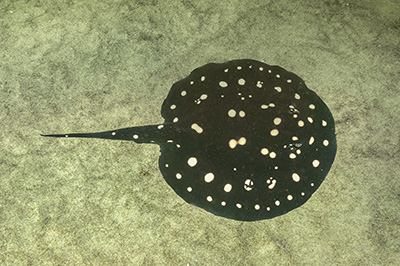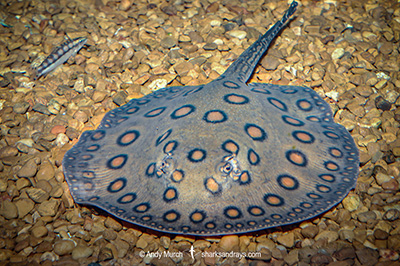Common names
Tapajos River Stingray, Itaituba Ray, Whitespotted Freshwater Stingray.
Binomial
Potamotrygon albimaculata.
Synonyms
None.
Identification
A medium to large sized freshwater stingray with an oval disc that is slightly longer than wide. Snout broadly rounded with or with a small central lobe. Eyes small and somewhat pronounced. Spiracle length ≥2x orbit length. Nostrils thin. Nasal curtain skirt-shaped. Mouth small and slightly arched with 5 oral papillae.
Small denticles on central disc. Denticles sparser towards disc margin. Pelvic fin posterior margins slightly posterior to (or level with) disc. Tail shorter than disc width, broad anteriorly, slender towards tip. Dorsal, lateral, and ventral finfolds present. Tail beyond broad anterior section often damaged or absent. Multple rows of low thorns dorsally on tail. Caudal stings well developed.
Colour
Dorsum black or brownish black with numerous small white or cream spots. White spots smaller towards disc margin. In larger adults, spots may break up into irregular clusters of small spots and whorls on a white flecked black background. Tail solid black distally.
Ventrum mostly dark greyish brown except for white central disc and snout.
Size
Maximum disc width 50cm. Disc width at birth approximately 10cm.

Conservation Status
NOT ASSESSED
The Tapajos River Stingray (Potamotrygon albimaculata) has not been assessed by the IUCN. However, all potamotrygonid rays are facing habitat degradation, fishing pressure, and stress from collection for the aquarium trade.

Habitat
Tropical freshwater lakes and river systems. The Itaituba river stingray is more common in the deeper central troughs of rivers but is also found along the banks.
Distribution
South America. The Tapajos Freshwater Stingray is found in the mid to upper section of the Tapajos River basin. It is common in the Teles Pires River and its tributaries.
Reproduction
Viviparous. 2 pups per litter. Gestation period 4 months.
Diet
Diet consists of insects and small fishes.
Behavior
Poorly known.
Reaction to divers
Fairly easy to observe while snorkeling, but generally bolts or slowly moves away when approached closely.
Diving logistics
The best place to snorkel with Tapajos River Stingrays is in the clear, spring fed tributaries of the Teles Pires River in southern Para.
What’s new
View our full list of updates
Similar species
Xingu Freshwater Stingray (Potamotrygon leopoldi) Distinguished by larger, more uniform white spots and more easterly range in the Rio Xingu.
Ocellate Freshwater Stingray (Potamotrygon motoro) Although P. jabuti juveniles are superficially similar, adult pearl whiprays have a more intricate pattern and larger ocelli with proportionately smaller gold centres.










